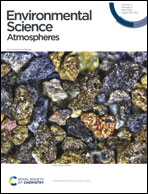What controls the observed size-dependency of the growth rates of sub-10 nm atmospheric particles?†
Abstract
The formation and growth of atmospheric particles involving sulfuric acid and organic vapors is estimated to have significant climate effects. To accurately represent this process in large-scale models, the correct interpretation of the observations on particle growth, especially below 10 nm, is essential. Here, we disentangle the factors governing the growth of sub-10 nm particles in the presence of sulfuric acid and organic vapors, using molecular-resolution cluster population simulations and chamber experiments. We find that observed particle growth rates are determined by the combined effects of (1) the concentrations and evaporation rates of the condensing vapors, (2) particle population dynamics, and (3) stochastic fluctuations, characteristic to initial nucleation. This leads to a different size-dependency of growth rate in the presence of sulfuric acid and/or organic vapors at different concentrations. Specifically, the activation type behavior, resulting in growth rate increasing with the particle size, is observed only at certain vapor concentrations. In our model simulations, cluster–cluster collisions enhance growth rate at high vapor concentrations and their importance is dictated by the cluster evaporation rates, which demonstrates the need for accurate evaporation rate data. Finally, we show that at sizes below ∼2.5–3.5 nm, stochastic effects can importantly contribute to particle population growth. Overall, our results suggest that interpreting particle growth observations with approaches neglecting population dynamics and stochastics, such as with single particle growth models, can lead to the wrong conclusions on the properties of condensing vapors and particle growth mechanisms.



 Please wait while we load your content...
Please wait while we load your content...